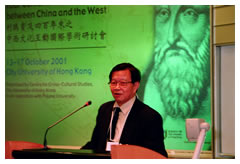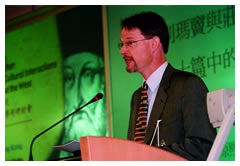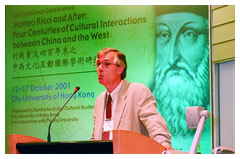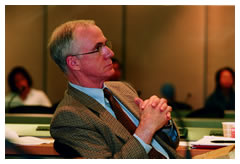Legend and legacy: Matteo Ricci and others
Matteo Ricci, the Jesuit missionary who visited
Professor Zhu is the editor of Matteo Ricci's Writings and Translations in Chinese, published jointly by the City University of Hong Kong Press, the Centre for Cross-Cultural Studies, and
"From a religious point of view, Ricci was the first missionary to succeed in securing a foothold for Christianity in
Professor Zhu pointed out that it was because of Ricci's writings in Chinese and translations of Western writings into Chinese that Chinese people started to learn about European culture after the Renaissance. He introduced Western knowledge of such topics as astronomy, geography, mathematics, physics, chemistry, medicine, architecture and irrigation to
"In the past, Western scholars' research relied mainly on Ricci's diaries and letters in Latin. In fact, most of Ricci's works were published in Chinese. But for a long time, his Chinese works were not well organized," said Professor Zhu. He believes that to get a thorough understanding of Ricci's thoughts, academics have to start with original materials, which was the main reason for the compilation of Matteo Ricci's Writings and Translations in Chinese.
Using Daoism to promote Christianity
Professor Haun Saussy, Associate Professor of Chinese and Comparative Literature atAt the conference, Professor Saussy read an essay titled "Matteo Ricci, the Daoist". Based on descriptions by late Ming literati who were acquainted with Ricci, as well as on the book Jiren Shipian (Ten Essays on Exceptional Men), written in Chinese by Ricci himself, the essay explores how Ricci decided to assume the guise of a Daoist after being mistaken as a believer in Daoism, in an effort to achieve his purpose of spreading Jesuit beliefs. Professor Saussy believes that Matteo Ricci was not really interested in Daoism, nor did he learn about Daoism to acquire knowledge. His ultimate purpose was to spread Jesuit beliefs. "He knew that those who were reading Daoist books were after another kind of knowledge and would be more easily influenced. They were his best targets for conversion," he said.
Analyzing the poem "For Li Xi Tai", written by the poet Li Zhi for Matteo Ricci, Professor Saussy pointed out that although Ricci did not lead a xiaoyao (leisurely and care-free) life on his mission in China, Li Zhi used the philosopher Zhuangzi's term, xiaoyao, to describe him. "This shows that Chinese literati at the time treated Ricci as a modern-day Zhuangzi who came to enlighten and disturb," he said. "Ricci must have determined that the echo of Zhuangzi would be strategic-it would help to establish him in the world of Chinese letters. It was, for Chinese readers, a familiar sign of unfamiliarity."
This is also why he believes that in his book Jiren Shipian Ricci used Zhuangzi's term jiren (exceptional man) to describe himself and to explain the God-related concepts, which were outside Chinese traditional thinking.
Using Chinese terms to introduce Western knowledge
When Matteo Ricci arrived in"Matteo Ricci understood that alien Western knowledge would be resisted by the Chinese. So he made use of gezhixue (the investigation of things and fathoming of principles)-which already existed in Chinese philosophy -to explain Western natural philosophy, science and religion, etc., to make it easier for the Chinese to accept. Using this approach, he converted several fairly influential Chinese literati, such as Xu Guangqi and Li Zhizao," explained Professor Hsu Kuang-tai of the
In recent years, Professor Hsu, a specialist in the history of science, has focused on Ricci's discussions over gezhixue. At the conference, he read his essay "The Encounters of Chinese and Western Intellectuals Relating to the Issue of li in the Late Ming Dynasty-Pioneered by Matteo Ricci".
The concept of gezhixue comes from the philosopher Zhu Xi's gewu zhizhi theory, which refers to the knowledge system involving nature, science and especially yinyang, developed by a group of intellectuals in the Song and Ming Dynasty, whom Zhu represented. It is also known as li xue. Professor Hsu explained the different traditions related to li held by Jesuit missionaries and Chinese literati in the late Ming Dynasty period. He analysed how the Jesuits used the traditional Chinese li concept as a means of introducing Western theories on humanitarianism and the origin of the universe to Chinese literati at the time.
Professor Hsu noted that Ricci first adopted the li concept in his book Tianzhu shiyi (The True Meaning of the Lord of Heaven), then expanded the concept to include mathematics in
Professor Hsu also pointed out that missionary work is normally done through two approaches-to bring people to the church is only one of them, the other way is to preach through nature, the works of God. And Matteo Ricci used the latter.
The impact of Jesuit missionaries on politics
Professor Huang Yi-long, also from the"How did the Manchu, with only a few hundred thousand people, conquer the Ming Empire in such a short time? Historians may give you all the political, social and economic reasons. But undeniably, military technology also played an important role," Professor Huang said. Based on this thinking, he focused his research on the advanced weapons Jesuit missionaries brought to
He pointed out that the Jesuits, led by Matteo Ricci, introduced Western military knowledge and cannons to help Ming rulers resist foreign invaders. The scientist and translator, and early Christian convert, Xu Guangqi was one of Ricci's best students in this area at that time. Unfortunately, the Ming court did not pay enough attention to the advantages of using Western weapons and only used them in critical situations. Later, those advanced cannons were used by the Manchu to conquer the Ming court. "The missionaries were there to help defend the Ming against the Manchu," Professor Huang said. "Little did the Ming expect that their techniques would be totally assimilated by the Manchu, to whom they lost their empire."
Through thorough research and visits to the remains of ancient forts on mainland China, Professor Huang concludes that although Western cannons were introduced during Ricci's stay in China, they gradually fell into disuse once the Qing Dynasty accomplished its task of unifying China. This was why cannon-related knowledge and technology developments towards the end of the Qing dynasty fell a long way behind the level of the late Ming dynasty, far from enough to meet later challenges from Western powers. "Through the introduction of Western cannon technology to
Talking about death with Chinese intellectuals
Today, many people are still not clear about when the first steps were taken in the cultural interactions between
Professor Brook also chose Jiren Shipian as the starting point of his discussion. In his talk, "Dialogues between Matteo Ricci and Xu Guangqi", he explored the conversations between the two over the issue of death. "Death is an important philosophical concept in Western Christian culture, but not in Chinese culture," he said. "In the late Ming, when intellectuals held deep-rooted beliefs about death and related philosophical issues, could they really understand and accept the language and interpretations Matteo Ricci adopted? Did Matteo Ricci really understand Chinese and the Chinese culture as we now imagine?"
To answer these questions, Professor Brook analysed, word-by-word, the fourth article in Jiren Shipian, "Thinking of Death and Preparing for the Last Judgment". He concluded, "If you read Jiren Shipian carefully, you will realize that Matteo Ricci was only using his knowledge of Chinese culture for his missionary work, and not for promoting cultural exchanges. Thus his efforts cannot be considered a very good cross-culture performance."
Exploring scientific transmission between cultures
In his talk, "Some Reflections on Scientific Transmissions and Scientific Changes", Professor Kim Yung-sik, of
"Some of the transmitted concepts can be adopted, others can lead to major conflicts within the dominant belief-systems of the accepting culture. It is worth exploring what transmitted science experiences after being introduced to a new culture," he said.
Professor Kim focuses on developing the possible research area of "comparative history of science" from the point of view of scientific history. In his talk, he explored the scientific transmission between East Asian countries and
Using
Professor Roger Hart, from the Department of History at the
On the other hand, since the Chinese literati elite also wanted to spread the religion, though they knew little about science, they passionately sang the praises of the superiority and practical efficacy of Western learning. Professor Hart concluded that the transmission of Western learning to
The conference included many other discussions about the Western learning introduced by Jesuit missionaries in the late Ming dynasty, such as mathematics, physics and astronomy. For example, in his talk titled "From Xu Guangqi to Hua Look-keng: The Legacy of Matteo Ricci and the Rise of Modern Mathematics in China", Professor Joseph W Dauben, Professor of History and the History of Science from City University of New York, shared his thoughts on how China, since the introduction of Euclid by Ricci, gradually established modern Chinese mathematics. Professor Iwo Amelung, from the Department of Middle Eastern and Far Eastern Languages and Cultures D Chinese Studies at Friedrich-Alexander University Erlangen-Nuremberg, talked about the long process of physics becoming a widely acknowledged science after the initial introduction by Jesuit missionaries. And Professor Fung Kam-wing of the
Although a wide variety of topics was covered at the conference, Professor Richard Smith of




